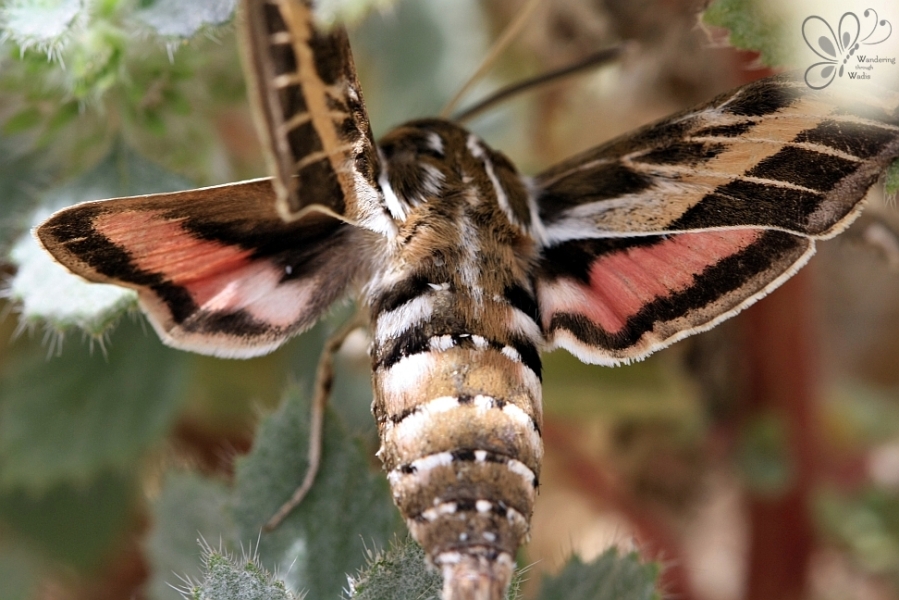I promised – to those of you follow on Facebook – that my next post would be about this magnificent critter that I found on a basil plant in my garden –

– as he was indeed the inspiration for getting back to work on this blog, and so today is all about…hawkmoths!
Unfortunately, I do not know – yet! – exactly who this bright green caterpillar is, but I do know that he (or she) is in the Sphingidae family of moths. Moths in this family are commonly called hawkmoths, sphinx moths, or hornworms. [Update: A year after I wrote this post, I was able to rear one of these caterpillars indoors; I believe it’s a Convolvulus Hawkmoth.]
There are over 1,450 species of Sphingidae moths. The larvae, or caterpillars, of hawkmoths are hairless and have a “horn” on the posterior end.

Striped Hawkmoth (Hyles livornica)
And while I do not know which caterpillar was munching on my basil plant, I do know who was bending over backwards to eat the tips of desert lavender. That is a larva of the Striped Hawkmoth, Hyles livornica.
It was early spring 2013 and we had had a wet winter in Dahab. There had even been a hail storm in November. So the desert plants were flourishing in the wadis!
On one early morning wander, we came across an area lush with fresh green asphodel, lavender, and sorrel. And crawling across the sandy wadi were the most amazing caterpillars I had seen in Sinai! Dozens of them. Some of the largest were as long and thick as my index finger. They were happily munching on all the nearby herbs.



Like all caterpillars, these Striped Hawkmoth larvae go through several stages of development, or instars, and their colors and patterns can change quite dramatically at each stage.

Hawkmoth caterpillars will burrow into the soil or gravel or hide among the rocks to pupate and I have never seen that stage of development. But about a month after we saw the caterpillars, we discovered the adult Striped Hawkmoths. They were busy feeding on the dhafrah (Iphiona scabra) flowers.

Sphingidae moths are known for their rapid flight and ability to hover in midair while they feed. They use their long proboscis (mouth parts) to reach the nectar in the flowers. Male moths are typically smaller than females. Both are beige with white stripes. Their hindwings, not seen when the wings are at rest, are pink and edged with black and white.

a Striped Hawkmoth, attracted to the light in the tent during a spring safari

Dahab was blessed recently with several good rainstorms and young desert plants are already poking their heads through the sand. Let’s hope the plants start to thrive again and that we have beautiful green wadis to wander through this coming spring. The butterflies and moths would be happy with that, too!
References:
Hyles livornica ~ Moth and Butterflies of Europe and North Africa

Thank you for such an interesting blog Bernadette. Looking forward to th next!
LikeLike
Thanks, Chris! I’m so pleased that you are enjoying the blog. 🙂
LikeLike
Hi I live in Washington state I found a hawk moth at my carport door I know they are not from here should. I report it to some one?
LikeLike
Beautiful!
LikeLike
They are, aren’t they? Thanks. 🙂
LikeLike
Pingback: Convolvulus Hawkmoth – Wandering through Wadis
Pingback: Moths in Sinai – Wandering through Wadis
Pingback: Eastern Death’s Head Hawkmoth – Wandering through Wadis
Pingback: Oleander Hawkmoth – Wandering through Wadis